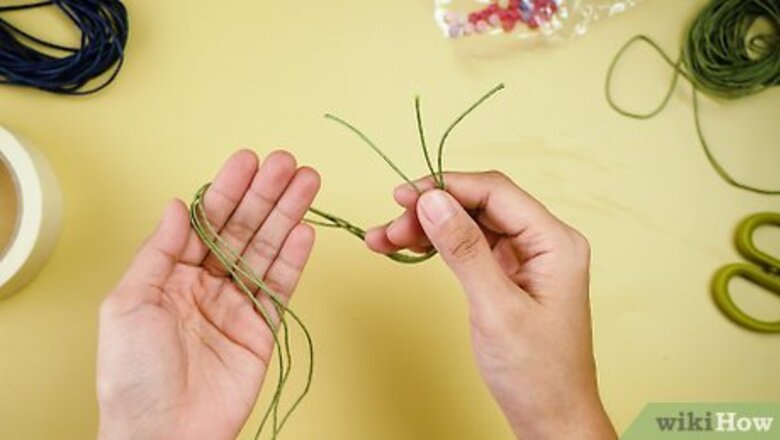
views
Cutting and Positioning Cord
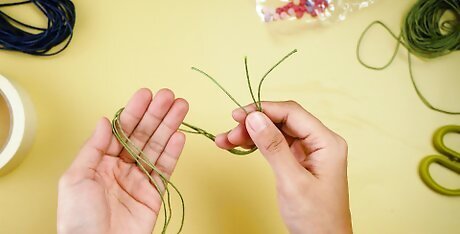
Cut 3 metres (9.8 ft) of cord into 3 equal parts. Lay the cord out flat in a long line or fold it into 3 lines to line up your cuts. Then, use scissors to cut the long 3 metres (9.8 ft) cord into 3 1 metre (3.3 ft) pieces. Making them as even as possible will ensure you don’t run out of any single cord when you’re making square knots.
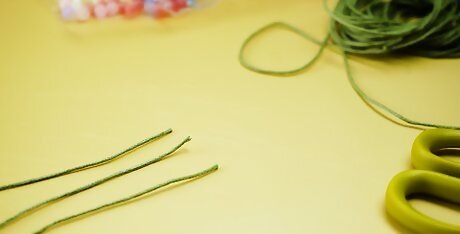
Separate each length of cord and lay them parallel to each other. Tease the cords apart if they’re tangled and lay them so they’re parallel to each other, lining them up evenly at one end. It's important to ensure they're lined up evenly so any single cord doesn't run out before the others. If any of the cords are drastically shorter than the others, you may need to recut a longer string and try again.
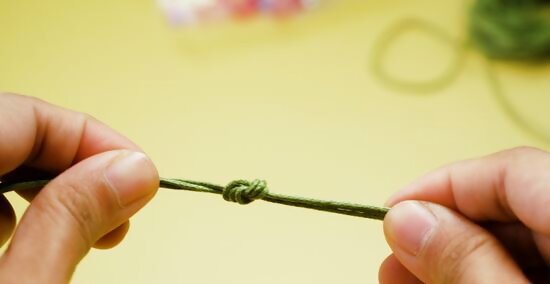
Tie a loose knot about 5 inches (13 cm) to 6 inches (15 cm) down. Move your hands 5 inches (13 cm) to 6 inches (15 cm) down from the lined up ends and tie a loose knot. To tie the knot, loop all 3 cords around your finger and then pull the short end through the loop. Don't pull it too tight because you'll be undoing it later on.
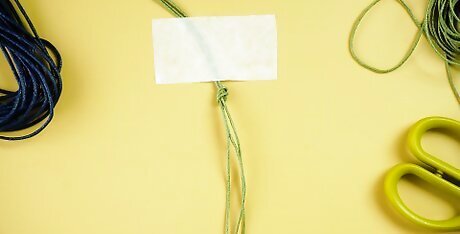
Tape the knotted side onto a table to hold it in place. Tear off about 3 inches (7.6 cm) of tape from the roll and secure the cords to the table just above the knot. Tape it towards the far edge of your working table so you have the full area of the table to work on. This will make it a lot easier to tie square knots and keep the ends of the cords from tangling together.
Knotting
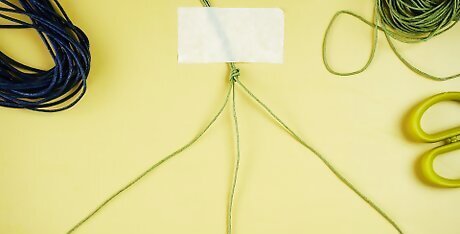
Separate each cord so they resemble a small teepee. Lay the 3 cords separate from each other. You’ll have cord number 1 on the left, number 2 in the middle, and number 3 on the right. The bracelet is made using macrame to make square knots.
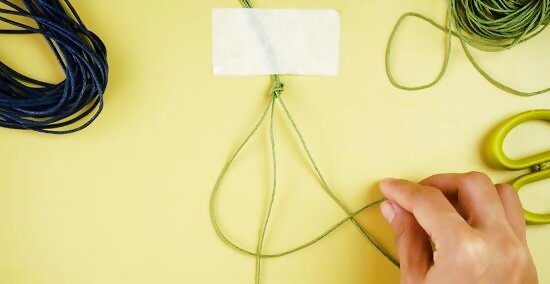
Place cord 1 over the top of cords 2 and 3. Pick up cord number 1 and lay it horizontally across cords 2 and 3. It should lay flat across the top of the other cords. You’ll end up with a shape that looks like 2 triangles side by side.
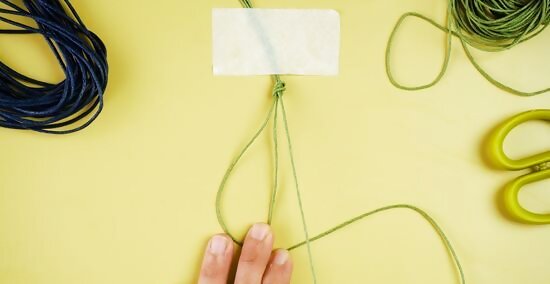
Put cord 3 back over the top of cord 1. Slide cord 3 out from beneath cord 1 and reposition it in the same place on top of cord 1. Cord 1 will now be laying on top of cord 2 and under cord 3. Pull the cords taut to keep them separated and prevent the ends from tangling. It may help to hold cords 1 and 2 in place with your left hand while you reposition cord 3.
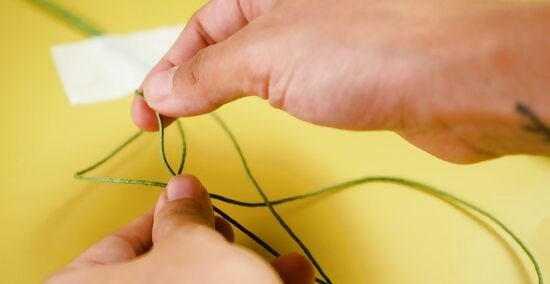
Run the end of cord 3 through the loop made by cords 1 and 2. Pick up the end of cord 3 and run it under and through the loop made with cords 1 and 2. It should run under the center part where cords 1 and 2 meet and on top of the left side of cord 1. It may help to hold down cords 1 and 3 with a finger while you pull the end of cord 3 through the loop.
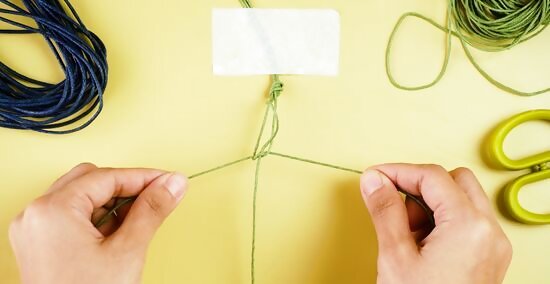
Pick up cords 1 and 3 and pull them tight to form a knot. Pull the cords on the left and right (cords 1 and 3) tight all the way up to the top (just under where you made the first regular knot). Make sure to pull the knot tight so it stays in place while you make the rest of the knots. Make sure the middle cord is running straight down while you pull the cords on either side. This completes the first half of a single square knot on the shamballa bracelet.
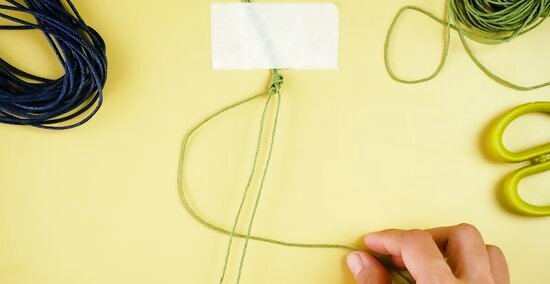
Repeat the same process but run the cords underneath. Repeat the same process with cord 1 but instead of putting it on top of the other 2 cords, run it underneath them. Then, pick up cord 3 on the right and run it under cord 1. Run the end of cord 3 over and through the loop made by cords 1 and 2. Pull the cords tight just like you did before, keeping cord 2 running straight down the center. This completes a single square knot.
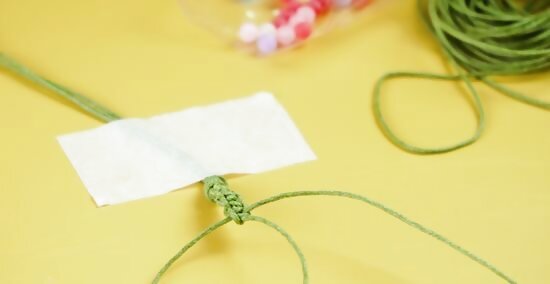
Create 4 to 6 more square knots. The idea is to make a line of square knots until it's time to add the first bead in place. A good guide is to make 4 to 6 knots before adding the first bead. The more knots you do, the longer the bracelet will be, so keep that in mind if you have a small or large wrist circumference.
Adding Beads
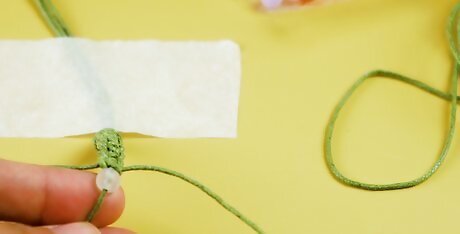
Thread a bead onto the middle cord (cord 2). Run the end of cord 2 through the bead’s center hole and push it all the way up against the last square knot you made. It may slip as you continue tying square knots, so just be sure to push it all the way up again at the end of your next half-knot. If the bead has flat or decorative sides that you want to be showing while you wear the bracelet, make sure to rotate the bead into the proper position at this time.
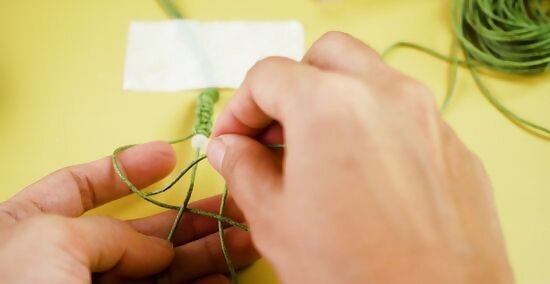
Tie the next square knot right under the bead. Start as you did in the first step, picking up cord 1 and placing it over cords 2 and 3. Then, place it on top of cord 3 before you run the end of cord 3 through the loop made by cords 1 and 2. Make sure to pull it taut to secure the bead in place. The idea is to trap the bead within the square knot.
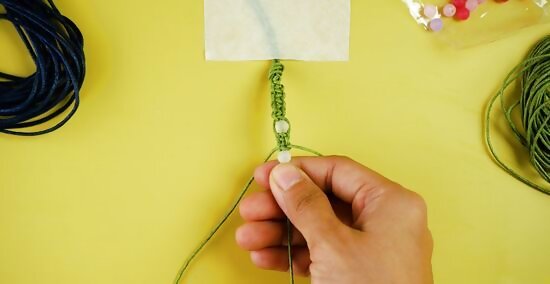
Make 2 more square knots until it's time to add the next bead. Complete the square knot by performing the same sequence of arranging the cords but reversed. That is, run cord 1 under cords 2 and 3, then place it above cord 3 in the same position. Next, string cord 3 over and through the center loop. You may want to measure the bracelet around your wrist as you go to ensure that it will be the right size. You don’t have to undo the tape, just carefully lift the bracelet up and lay it across your wrist to gauge how much longer it needs to be. Add in each bead as before, trapping each bead within a square knot. Use a total of about 5 or 6 beads, depending on your wrist size or the desired size of the bracelet. Keep the gaps between beads and the lengths at either end symmetrical for a professional-looking bracelet. Note that the size of the beads may impact how many you add too, so adjust your plan accordingly.
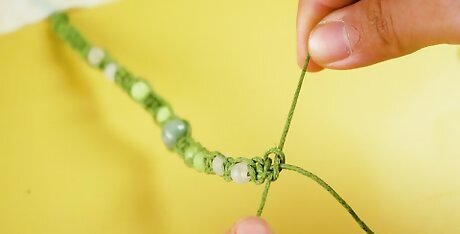
Finish the other end-side of the bracelet as you began. After you’ve added all of your beads, make the exact same amount of square knots as you made at the start. Keeping it even will ensure the beads are centered on the bracelet. If you discover the bracelet is going to be too long, you can backtrack by undoing some of the knots and a bead. You may need to use a dull nail or other small tool to undo the knots.
Tying off the Bracelet
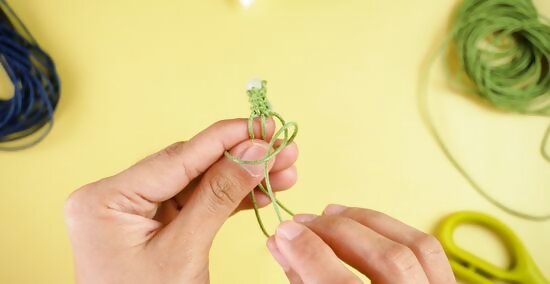
Tie off the bracelet after you’ve tied the last square knot. After finishing the last knot, remove the tape to free the bracelet and flip it over so the backside is facing up. Then, use the cords on either side (1 and 3) to tie a tight knot. This is a regular knot (not a square not), made by looping the cord around your finger, running the end through the loop, and pulling it taut.
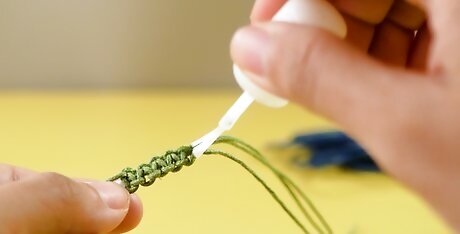
Place a dab of glue onto each side of the knot. Dab on enough superglue to cover the knot and let it dry for at least 1 hour. Then, flip over the bracelet so the front is facing up and do the same thing. It may help to use the head of a small nail or toothpick to push the glue into the small crevices between the cords. It may take more or less time for the glue to dry—refer to the instructions on the package.
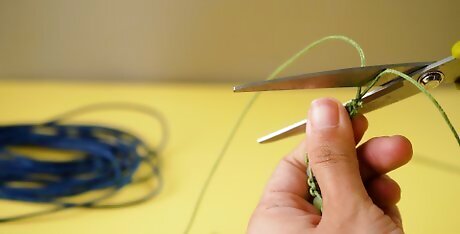
Cut off the 2 outer cords to the base of the glued knot. Place the blades of your scissors as close to the knot as possible and snip off the 2 outer cords. Leave the middle cord uncut. The 2 middle cords at either end of the bracelet should now be the only cords left.
Making the Clasp and Bead Tassels
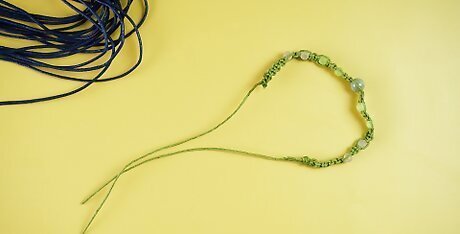
Cut the 2 ends down until they’re the same size. Lay the bracelet as if you’re looping it around your wrist and pull the 2 ends straight. Then, use scissors to snip them so they’re the same length. Leave at least 5 inches (13 cm) of cord on either side so you don’t accidentally make it too short to fit around your wrist.

Place a 1 metre (3.3 ft) long cord under the 2 bracelet cords. Loop the single cords together as if you would on your wrist. Then, run the 1 metre (3.3 ft) long cord under both of these cords. Make sure to hold it at the center point of the 2 cords. It’s okay if your extra cord is a little less than 1 metre (3.3 ft), it’s just helpful to have extra if you can.
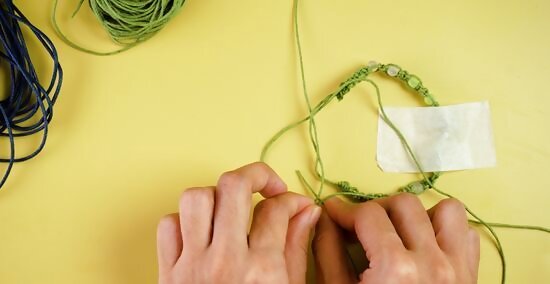
Make a loose square knot. Treat the 2 middle cords as the center cord (2) and the new piece of cord as the left and right cords (1 and 3) and tie a square knot just as you did on the main part of bracelet. Keep this fairly loose because it needs to slide so you can adjust the length of the bracelet. Remember, you’ll be making 1/2 of the square knot but running the cords over the top first then underneath.
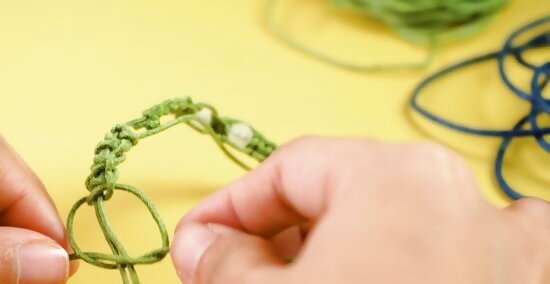
Make about 5 more loose square knots and tie it off. After you’ve made a row of 5 or 6 square knots, tie off the ends just like you did the other ends of the bracelet (flipping it to the back and tying a knot using the outside strings). Skip gluing the final knots because you’ll need them the cords to be able to slide around.
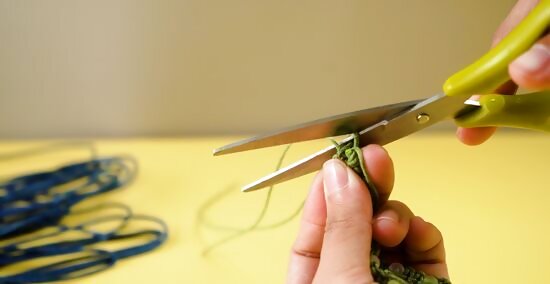
Cut off the ends to leave 1 cord on each side of the square knots. Use your scissors to snip off the extra cord, leaving about 3 inches (7.6 cm) to 4 inches (10 cm) of cord on either end. Leaving extra cord on either end will allow you to make the bracelet larger so you can slide it on and off.
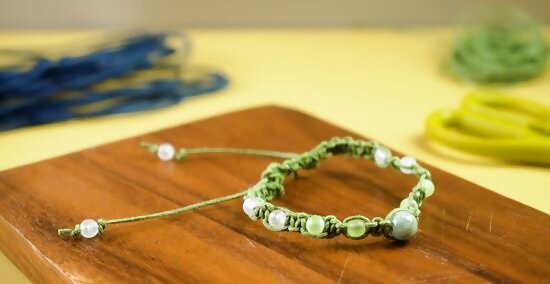
Add a final bead to each end of the 2 loose cords and cut the extra off. Tie a knot toward the end of the first cord, leaving enough space for the bead and a final knot. Slide the bead into place next to the knot and secure it with another knot. Cut the last bit of cord underneath each final knot to complete your bracelet. Use a regular knot for this step, looping the single cord around your finger, running the end through the loop, and pulling it taut. You can use any bead for the end pieces—regular beads or shamballa beads if you want a monochromatic bracelet.
















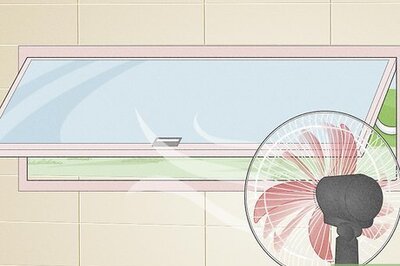

Comments
0 comment